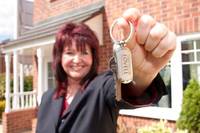Shared Equity – The facts
 While mortgage lending remains restricted and most products unattractive unless a substantial deposit is available, shared equity is fast becoming the easiest way for first time buyers to become home owners and movers up to secure the space they need now.
While mortgage lending remains restricted and most products unattractive unless a substantial deposit is available, shared equity is fast becoming the easiest way for first time buyers to become home owners and movers up to secure the space they need now. Despite its seeming popularity however, housebuilder Lovell Eastern is finding visitors to its new homes developments are still confused by the jargon, believing that such a good deal must have a catch. So what exactly is shared equity? And can it really help people without a big enough deposit onto the property ladder.
Sales advisor Beverley Johnson at Lovell’s The Glades development in Nottingham explains. “If you’re currently house hunting it’s easy to feel overwhelmed by all the different deals being marketed, especially when it comes to shared equity. There are so many versions, all with different names, some government backed and others privately funded, that it’s no surprise that buyers feel totally confused.
“Moreover, most people are suspicious about what shared equity will actually entail and are concerned that if they take the plunge now there’ll be something in the small print that comes back to bite them later on.
“Shared equity doesn’t have to be such a minefield though; with a bit of plain talking anyone will see how it can actually provide a genuine route to homeownership.”
Lovell outlines the facts about shared equity:
Shared equity is quite simply a payment deferral system that allows a purchaser to pay for an agreed portion of a property now and leave payment on the remaining portion until a later date.
Crucially though, the person owns 100% of the property and has absolutely no rent or interest to pay on the bit they’ve deferred.
The deferred portion is usually 25% but can be 15% should the purchaser be able to afford more.
Better still the Lovell deal is private and not government funded, so there’s no housing association to answer to, no lengthy forms to fill out and absolutely no stigma attached to participating in the scheme.
The purchaser has up to 10 years to repay the deferred amount, which is calculated at market value at the 10 year point, or when the property is sold or the mortgage redeemed, which ever is sooner.
Alternatively the homeowner can choose to pay off lump sums during the 10 year period. The part sum repaid must be 10% of the purchase price or £20,000, whichever is lower.
The deferred amount is effectively a free loan from the housebuilder, which many lenders will take as a deposit, leaving the buyer able to secure a mortgage, without having to stump up the cash themselves.
As part of Lovell’s commitment to plain talking a free fact sheet about shared equity is available to download on the website lovell.co.uk. A jargon buster can also be found to help make sense of the many other homebuying terms.
Currently Lovell is offering its plain talking shared equity scheme on selected homes The Glades. The deal allows buyers to move into a property for just 75% of purchase price and defer the remaining 25% for up to 10 years or until the property is sold, whichever is sooner.
For example plots 87 and 88 are available with shared equity. Both are traditionally planned, semi-detached three-bedroom houses called the Moreton. They have their own driveway, rear garden as well as three bedrooms, master with en-suite and a family bathroom. Downstairs the accommodation comprises cloakroom, kitchen and a large living dining room.
The Moreton style home is priced from £139,950, however with shared equity buyers would only need to take a mortgage out for 75% of this, plus 5% from Lovell making the initial cost just £99,714.
Bev concludes, “Just this year already six buyers at the development have bought a home using shared equity and the majority of our enquiries are from customers interested in the scheme. So the message is clear, if you think you can’t buy your own home, think again and come and talk to us about how shared equity can provide a lifeline. As one of the country’s leading provider of affordable new homes, we know what we’re talking about!”
The Glades is located on Bakewell Drive in Nottingham. The sales office and show home is open Thursday to Monday from 10am until 5pm. For more information log on to lovell.co.uk.




